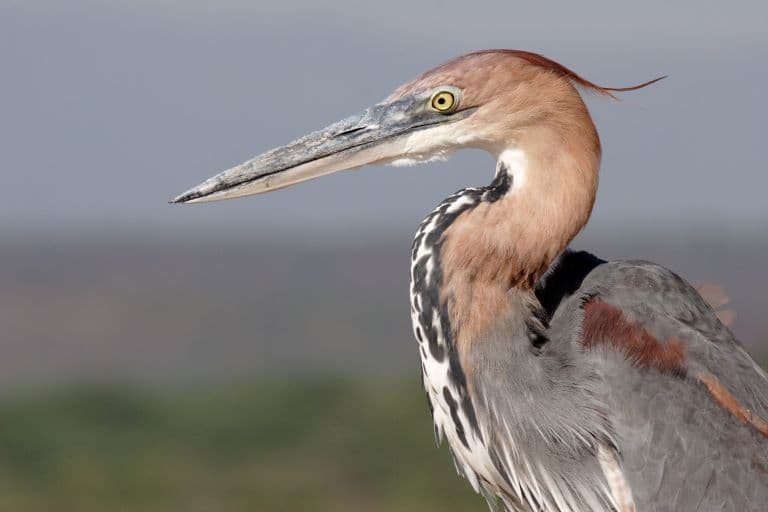Goliath Heron Profile
The herons are a family of slender, predatory birds known for their ability to sit alone, knee-deep in water, watching, waiting, and then striking, face-first into a fish.
They’re the anglers of the bird world: solitary, quiet and often wet and miserable. There are around 70 species, found almost all over the world, with the smallest being the dwarf bittern – a 30 cm-long feathered dart.
But at the end of the spectrum, the Goliath heron stands at an incredible 1.5 m tall – that’s just shy of one Salma Hayek.

Goliath Heron Facts Overview
| Habitat: | Sores of coastal and inland freshwater and saline waters |
| Location: | Sub-Saharan Africa, small populations in Asia |
| Lifespan: | Up to 23 years in captivity, 15 in the wild |
| Size: | 1.5 m (5 ft) tall, 2.3 m (7 ft 7 in) wingspan |
| Weight: | Around 5 kg |
| Colour: | Reddish-brown neck and underparts, blue-grey back and wings, black and white flecked throat |
| Diet: | Mostly large fish; also frogs, lizards, snakes, rodents, crabs, prawns and carrion |
| Predators: | Raptors |
| Top Speed: | Slow |
| No. of Species: | 1 |
| Conservation Status: | Least Concern (IUCN) |
Goliath herons, as the name might suggest, are very large birds. And with this size comes a goliath appetite.
They will eat almost anything that wriggles – and even some things that don’t – though their first choice is a very large fish.
Being solitary hunters, they rarely make sounds but will bark when necessary, and begin their lives in an immediate battle royale with their siblings, the survivors growing into the top predator of their habitat.
Interesting Goliath Heron Facts
1. They’re huge
The Goliath heron is aptly named. It’s the largest of all the herons and stands at a whopping 1.5 metres tall.
But this is a slender bird, too, and tops out at around 5 kg, which is significantly less than a large Muscovy duck.
So, this is a low-density animal, but to make itself look bigger it sports an incredible reddish-brown crest and bushy neck feathers that can be fluffed up to great effect. When fully crested, it looks a lot like a member of the fire gang from the movie Labyrinth. 1 2

2. They’re mostly solitary
This species lives in areas where there’s plenty to eat and no such thing as Winter, so there isn’t much reason for it to leave.
As such, the Goliath heron is non-migratory, though it will move between habitats if it finds a richer feeding site.
In general, like many herons, these animals are solitary, spreading out in low densities to occupy territories designated to a single heron, or rarely, a pair, who will claim it as their own.
They’re so well-spaced that they don’t even need to be all that territorial, but they can hold their own against predators. Anything too large, though, and they’ll flee.
3. They bark
Their mostly solitary nature doesn’t necessitate much in the way of vocal communication, so the Goliath heron sticks to the basics.
Their calls are described as variable between the “Kawoork” and the “Kroo”, though they would probably argue with the spelling. Usually, when disturbed, this bird will issue a loud “Arrk”, and the range of sounds tends to fit within the grunt and squawk spectrum.
But their bark is an impressive one. It can be heard from up to 2 km away and is a low-frequency, long-range call. 3
4. They’re methodical with their feeding
Spending so much time alone allows the herons to develop their own little eccentricities without the critique or social pressure of company.
These birds love to take their time and are naturally programmed for patience. They stand motionless for hours at a time, staring intently at the water, and perhaps, sometimes, at their own reflections (they are still birds, after all).
Some suggest that the beak itself functions as a lure; by placing it in the water, it sits as a large and stationary object that fish may be drawn to.
But these herons are known to overlook smaller prey and save their efforts for big fish, which, once they have caught, they will meticulously prepare over a lengthy period, setting it onto a floating bed of plants, positioning it, and getting ready to eat it.
Unfortunately, this ritual opens a window for the fish eagle, who, as a notorious bully and pirate, takes the opportunity to steal kills from the heron. In one study, 11% of the heron’s catches were lost in these altercations. 4

5. And they can eat a lot
But the herons factor in this ecological variable to their feeding economy. Even with eagle interference, they manage to eat around a third of their body weight in fish per day, and this amounts to just over 2 particularly juicy catches.
In the absence of inter-specific competition, this suggests that the body type of this bird has specifically evolved for its purpose, and makes this species highly specialised to hunting high-reward, large prey items.
6. But their nests are messy
You’d think a bird this deliberate in its movements (or lack thereof) would keep a clean shop, but herons will be herons, and this one keeps to the theme of nesting on what looks like the tree equivalent of a sneeze.
Goliath herons create a platform of reeds or sticks, usually over the water or on the shore, and preferably on islands, and these nests are around a metre across.
Inside these scrubby constructions, the female will lay between 2 and five eggs. But not all of them will make it out alive. 5 6
7. The sibling rivalries are brutal
Being born in a heron nest is essentially like waking up in the Thunderdome.
While the parents will play an active role in rearing their offspring to fledging, they allow a remarkable level of lethal competition to occur between chicks within that time.
Of the 2-5 eggs, only 1-2 will make it to independence, and this will usually be the largest and most violent.

8. They’re dominant predators
Sibling rivalry is a great way to select the meanest of a clutch of would-be predators. And the outcome in Goliath Herons is a dominant downward pressure on its ecosystem by what amounts to a top predator in much of its range.
Large fishes have little if anything worse to fear than the presence of this giant, statuesque angler, waiting in ambush to pierce it through the gills.
Goliath Heron Fact-File Summary
Scientific Classification
| Kingdom: | Animalia |
| Phylum: | Chordata |
| Class: | Aves |
| Order: | Pelecaniformes |
| Family: | Ardeidae |
| Genus: | Ardea |
| Species: | goliath |
Fact Sources & References
- “Goliath Heron”, Heron Conservation.
- “Goliath Heron”, iNaturalist.
- Author Name (Year), “Article Name”, Publication.
- Douglas W. Mock (1980), “Feeding Behavior and Ecology of the Goliath Heron”, Oxford Academic.
- “Goliath Heron”, MPALA Live.
- Goliath Heron (2012), “Goliath Heron”, Africa Wild.
